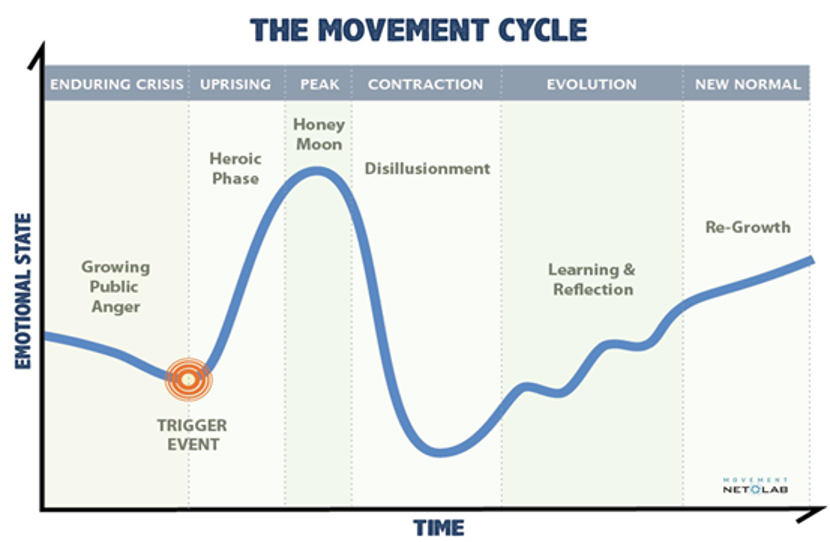Minds of the Movement
An ICNC blog on the people and power of civil resistance
by Isa Benros, Phil Wilmot and Søren WarburgMay 07, 2020
Historically, pandemics have forced humans to break with the past and imagine their world anew. This one is no different. It is a portal, a gateway between one world and the next.
-- Arundhati Roy
COVID-19 is an example of what movement analysts call a “trigger event.” When shocking events of immense scale occur suddenly—such as natural disasters, military coups, economic collapse, or virus pandemics—they drastically alter life as we know it, and radically shift public sentiment. The previously unimaginable quickly becomes reality.
Trigger events create confusion and unease, but they also present tremendous opportunities for those who have a plan and know how to use the moment to push their agendas. Those in power and private interest groups are already doing this to ensure that they will come out of the crisis with their wealth and position still intact. Activists must push an agenda that represents the public interest—the imperative of a just society and the rights of ordinary people—with effective strategies for advancing relevant new policies. Right now, there is a need for a platform and vision for mass participation, a well-articulated analysis of why we’re suffering, and a vision for how to achieve a better future. This can provide the sense of agency, shared story, and strategy that enables people to work collectively towards common goals.
How do we leverage this trigger event?
To leverage this trigger event, it helps to understand a broader perspective on social movements, and in particular different stages of movement development.
Inspired by the activist Bill Moyer’s stages of progression for social movements, Movement Net Lab designed “The Movement Cycle” to illustrate six phases of a movement’s life:
- Enduring Crisis, characterized by growing public anger.
- Uprising, characterized by a massive response of action.
- Peak, when members briefly enjoy a “honeymoon” sensation—the temporal thrill of victory.
- Contraction, when members are disillusioned that their great work has not fully ushered in the lofty change they expected. (Membership is likely to wane at this point, especially if core organizers had not prepared for it.)
- Evolution, guided by the learning and reflection of members.
- New Normal, characterized by consistent and modest regrowth (whether in the direction of movement goals or not) until another trigger event is seized.
As illustrated below, trigger events like the one we’re seeing now often occur between the first two phases:

As people are increasingly aggrieved by their circumstances, they become more willing to act. When a particular scenario unfolds that feels completely overbearing (a “trigger event”), organizers can seize it as a trigger event to spark mass uprising. Source: Authors.
As we see it, the top priorities for organizers, activists, and civil society in the current COVID-19 moment are:
- Understanding the Uprising (“Heroic”) phase and acting strategically during it.
- Preparing to enjoy the Peak (“Honeymoon”) phase in a way that limits the negative impact of the “Disillusionment” phase that follows, and that provides a basis for longer term growth towards success.
To advance these two priorities, here are capacities that movements, networked NGOs, allied financiers, and self-organized groups can build in this phase of social movement development.
Develop plans and processes to absorb new membership
In light of government failures to respond adequately to COVID-19, and the suffering and long-standing inequalities in our societies that this pandemic has exposed, many people are now newly awakened and will be motivated to take action. How can these people be recruited into movements, and then sustain their participation once they’ve joined? Answers to these questions will look different across different contexts, but they inevitably involve creating infrastructures that strengthen relationships between existing activists and new volunteers—for example by establishing affinity groups, events, social network groups, etc.
Because it can be challenging to do this in a time of social distancing, setting up virtual communities of practice that offer authentic human interaction through webinars and virtual workshops can help in this regard. One example is Nonviolence International and Beautiful Trouble’s ongoing “We are All Part of One Another” webinar series.
However, we also need to go beyond simply migrating to digital organizing spaces. Delegating leadership and encouraging self-organizing are crucial movement capacities right now. To cultivate more sincere human interaction, movements should ensure that newcomers don’t leave their first (likely virtual) meeting without being plugged into working groups or affinity groups. A follow-up plan for subsequent meetings or actions to take place should always be clear for attendees.
Convene communities to promote healing
We have all heard the mantras of individual self-care during this time (“Distance yourself! Wash your hands! Spend time in nature!”), but many people also have a need for broader shared healing. We need movements that have the capacity to convene communities and encourage collective healing, and empowerment, as part of their activities. Consolidating local caregiver information and forming volunteer groups are a few examples of ways we can mobilize solidarity for mental health support and serve the most hurting members of our communities.
Engage in mutual aid and expand coalitions
Mutual aid and community support networks are blossoming throughout the world to help those affected by COVID-19. Movement organizers must deepen relationships with those who are engaged in this community-based service work (and of course, in some cases movement organizers are the ones who are already doing this work).
Mutual aid and humanitarianism do not automatically raise political consciousness in and of themselves, but they can create the space for it. But when those engaged in mutual aid also help their communities understand how they can mobilize together to create political change, the results can be potent. Those serving local community needs can also deepen public understanding of existing system flaws such as economic disparities; inequalities in health care access and outcomes; public policies and budgets that favor armed defense over human security; and leadership incompetence (e.g. bailing out large companies operating in non-essential industries). This exposure can be channeled to challenge and transform the faulty system. Activists can also engage in charitable acts in ways that pressure the system to behave as it should.
Pool resources
Now is also the time to critically look at how you can collect resources and make them available to others. Pool funds for projects (one ongoing example is the Middle East Children’s Alliance’s Emergency Aid for Palestine and Lebanon During COVID-19 Pandemic). If you’re a nonprofit organization, you can publicly offer yourself as a fiscal sponsor. Develop a crowdfunding campaign with your comrades to support those suffering financially during COVIC-19. ActionAid has established a COVID19 youth-led action fund to do exactly that.
Draw on the leadership and skills of artists
Human resources are the most important resources a community has. Keep trainers, designers, artists, and people who are skilled in organizing and strategy at hand. In particular, artists (of all disciplines) are irreplaceable in their ability to elevate society’s capacity to imagine. NGOs, donors, and self-organized groups should turn to artists for their understanding and visualization of this crisis through a word, song, or image. Artists can also offer insight on the appropriate structures they need to carry out their work in support of social and political transformation. Inattentiveness to the visionary leadership of artists during COVID-19 will result in tone-deaf responses to a disaster felt by most as a deeply human hardship.
Beyond the value of artists’ visionary work, they are valuable local partners in more concrete actions, such as volunteering their currently unused workspace for hospital overflow (like this recent example from New York), or turning their attention to mask fabrication.
Develop and advance alternative policies
Capitalist economies of many countries worldwide are presently being bailed out by socialism! In some cases right-wing despots are being forced to use state funds for the wellbeing of their people. Yet even in cases where socialized policies are supporting populations, those that continue to pillage our planet are getting a fatter slice of the cake.
Beyond exposing system faults and reframing the pandemic to shift public opinion, we can also research and analyze specific policies and structures to advocate as alternatives to the status quo. As policymaking bodies currently under quarantine reconvene, the opportunity arises to pressure them to pass new economic, health-related, and other legislation and make changes within government. Being late to this game is not an option—the opportunity to push them to focus on the public interest and the needs of ordinary people is real, and we must be prepared to win that fight by building power and advancing policy alternatives.
It’s up to us: Another world is possible!
People worldwide are alert to the ramifications of COVID-19, and many are already organized and taking action to seize this crisis for the better. What remains to be seen is whether these fragmented efforts coalesce into collective power. Our ability to harness this power will determine whether we are able to leverage this pandemic in a way that transforms oppressive social, economic, and political systems. Our insights above provide a starting point for networked NGOs, allied financiers, and self-organized groups to consider how to use our present situation as strategically as possible. There is no need to feel powerless. The time is now to emerge from our paralysis and cultivate the new world together!

Isa Benros
Isa is a mother, anthropologist, and currently Organizing and Social Movement Documentation Coordinator at ActionAid Denmark. Isa has lived and worked in East Africa for years and done extensive qualitative research on youth and organizing in the informal sector in Kenya.
Read More
Phil Wilmot
Phil Wilmot is a former ICNC Learning Initiatives Network Fellow, co-founder of Solidarity Uganda, and a member of the Global Social Movement Centre and Beautiful Trouble. Phil writes extensively on resistance movements and resides in East Africa. Write to Phil at phil@beautifultrouble.org.
Read More
Søren Warburg
Søren Warburg is a dad, political organizer, social movement and civil resistance strategist, and Rosa Luxemburg lover (beware of the spontaneity of movements). He has been supporting movements globally for the past two decades and currently works as the Head of Youth Organizing and Activism at ActionAid Denmark.
Read More